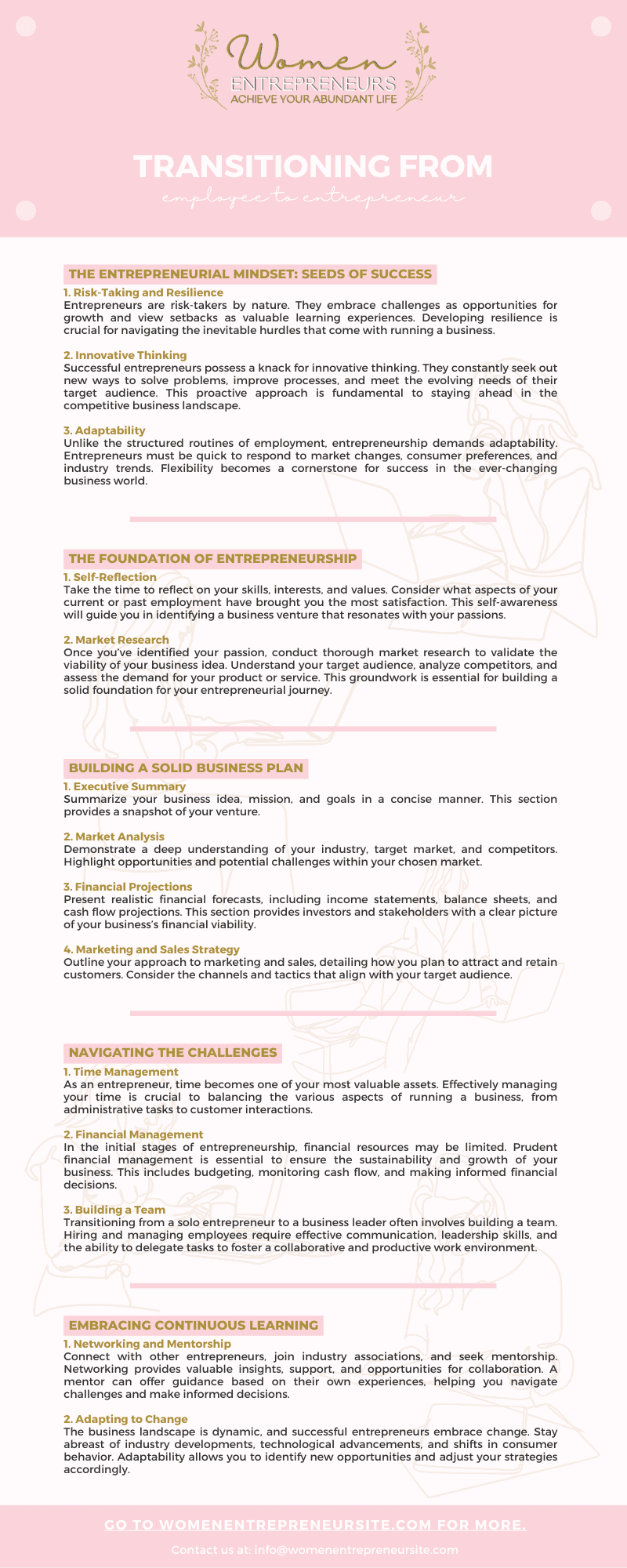In the dynamic world of entrepreneurship, negotiation is a crucial skill that can make or break…
Transitioning from Employee to Entrepreneur

In the realm of professional growth, there comes a pivotal moment for many individuals when the idea of transitioning from employee to entrepreneur takes root. This transformative leap signifies more than just a change in job title; it represents a shift in mindset, a departure from the safety of a steady paycheck to the uncertainty and excitement of entrepreneurial endeavors.
This article explores the various aspects of making this leap, from cultivating the entrepreneurial mindset to navigating the challenges of starting and running your own business.
>> Buy your own Wifi now! Manage your Social Media anytime, anywhere:
The Entrepreneurial Mindset: Seeds of Success
Before delving into the practical aspects of transitioning from employee to entrepreneur, it’s essential to cultivate the right mindset. Employees accustomed to a structured work environment may need to rewire their thinking to embrace the dynamic and often unpredictable nature of entrepreneurship.
1. Risk-Taking and Resilience
Entrepreneurs are risk-takers by nature. They embrace challenges as opportunities for growth and view setbacks as valuable learning experiences. Developing resilience is crucial for navigating the inevitable hurdles that come with running a business.
2. Innovative Thinking
Successful entrepreneurs possess a knack for innovative thinking. They constantly seek out new ways to solve problems, improve processes, and meet the evolving needs of their target audience. This proactive approach is fundamental to staying ahead in the competitive business landscape.
3. Adaptability
Unlike the structured routines of employment, entrepreneurship demands adaptability. Entrepreneurs must be quick to respond to market changes, consumer preferences, and industry trends. Flexibility becomes a cornerstone for success in the ever-changing business world.
Identifying Passion and Purpose: The Foundation of Entrepreneurship
One of the first steps in transitioning from an employee to an entrepreneur is identifying your passion and purpose. Entrepreneurial ventures often require a considerable investment of time and energy, so aligning your business with something you are genuinely passionate about increases the likelihood of long-term success.
1. Self-Reflection
Take the time to reflect on your skills, interests, and values. Consider what aspects of your current or past employment have brought you the most satisfaction. This self-awareness will guide you in identifying a business venture that resonates with your passions.
2. Market Research
Once you’ve identified your passion, conduct thorough market research to validate the viability of your business idea. Understand your target audience, analyze competitors, and assess the demand for your product or service. This groundwork is essential for building a solid foundation for your entrepreneurial journey.
She Means Business
Are you prepared to launch your business concept? Time to take action! By using a computer and an internet connection, you can share your ideas and communicate your message, as well as advertise your business in ways that were previously impossible.
Building a Solid Business Plan: The Blueprint for Success
A well-crafted business plan is the roadmap that guides your entrepreneurial journey. It serves as a blueprint for your business, outlining your goals, strategies, and operational plans. Key components of a comprehensive business plan include:
1. Executive Summary
Summarize your business idea, mission, and goals in a concise manner. This section provides a snapshot of your venture.
2. Market Analysis
Demonstrate a deep understanding of your industry, target market, and competitors. Highlight opportunities and potential challenges within your chosen market.
3. Financial Projections
Present realistic financial forecasts, including income statements, balance sheets, and cash flow projections. This section provides investors and stakeholders with a clear picture of your business’s financial viability.
4. Marketing and Sales Strategy
Outline your approach to marketing and sales, detailing how you plan to attract and retain customers. Consider the channels and tactics that align with your target audience.
Inspiration and Advice from over 100 Entrepreneurs
More than 100 extraordinary and influential women are profiled in this book, sharing their creative spirits, overcoming adversity, and sparking a global entrepreneurship movement. This collection of profiles illustrates what can happen when we follow our passions and dreams. The list includes media titans, ceramicists, hoteliers, tattoo artists, comedians, and architects.
Navigating the Challenges: From Solo Entrepreneur to Business Leader
The entrepreneurial journey is not without its challenges, and transitioning from employee to entrepreneur requires a shift in mindset from working for someone else to becoming the leader of your own venture.
1. Time Management
As an entrepreneur, time becomes one of your most valuable assets. Effectively managing your time is crucial to balancing the various aspects of running a business, from administrative tasks to customer interactions.
2. Financial Management
In the initial stages of entrepreneurship, financial resources may be limited. Prudent financial management is essential to ensure the sustainability and growth of your business. This includes budgeting, monitoring cash flow, and making informed financial decisions.
3. Building a Team
Transitioning from a solo entrepreneur to a business leader often involves building a team. Hiring and managing employees require effective communication, leadership skills, and the ability to delegate tasks to foster a collaborative and productive work environment.
Embracing Continuous Learning: The Entrepreneur’s Journey
The entrepreneurial journey is a continuous learning experience. Successful entrepreneurs recognize the importance of staying informed about industry trends, technological advancements, and evolving market dynamics.
1. Networking and Mentorship
Connect with other entrepreneurs, join industry associations, and seek mentorship. Networking provides valuable insights, support, and opportunities for collaboration. A mentor can offer guidance based on their own experiences, helping you navigate challenges and make informed decisions.
2. Adapting to Change
The business landscape is dynamic, and successful entrepreneurs embrace change. Stay abreast of industry developments, technological advancements, and shifts in consumer behavior. Adaptability allows you to identify new opportunities and adjust your strategies accordingly.
7 Steps to Becoming a Network Marketing Professional
More than two decades ago, Eric Worre experienced a transformative moment during a corporate event, which led him to commit to becoming an accomplished professional in network marketing. Since then, he has concentrated on acquiring the necessary skills to succeed, positively influencing numerous individuals worldwide.
Final Thoughts
Transitioning from employee to entrepreneur is a courageous and rewarding journey. It requires a combination of the right mindset, passion, strategic planning, and resilience. While challenges are inevitable, they also present opportunities for growth and innovation.
By cultivating the entrepreneurial spirit, identifying your passion, building a solid business plan, navigating challenges, and embracing continuous learning, you can embark on a fulfilling and successful entrepreneurial adventure.
Taking the leap is not just about changing your professional status; it’s about realizing your full potential and creating a legacy through the pursuit of your passions.










